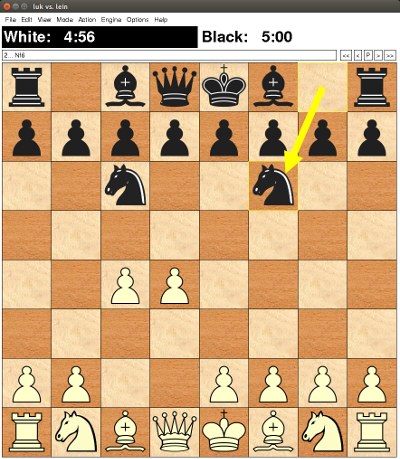"A game of chess is like a sword fight. You must think first before you move." (Shaolin and Wu Tang)
Swordfight is a chess engine (no GUI, just a chess AI). It's CECP-compatible and works with XBoard GUI.
- Download the latest release jar file.
- Install XBoard (should be available in your favorite package manager).
- Run
xboardand chooseEngine -> Load New 1st Engine. To add Swordfight as a new engine you need to set "Engine Directory" to to the directory containing the jar file and typejava -jar <jar_filename>in "Engine Command". This will make Swordfight play as black. - Play.
Alternatively if you want to run the latest version from the repository:
- Download this repo.
- Install Leiningen (requires Java JDK version 6 or later).
- Install XBoard.
- Run
xboardand chooseEngine -> Load New 1st Engine. To add Swordfight as a new engine you need to point to the repo directory and setlein runas command. This will make Swordfight play as black. - Play.
Swordfight currently uses parallelized alpha-beta pruning (YBWC) with Tomasz Michniewski's simplified evaluation function. If you run xboard -debug there will be some debugging info in the xboard.debug file.
You can also play without a GUI by running lein run and using a command line interface
like in the session below (user input is after the > prompt). A monospaced font in your
terminal is highly recommended for the debug output (chess board):
# {:xboard-mode false, :debug-mode true, :edition-current-color W}
# {:white-can-castle-ks true, :black-can-castle-qs true, :last-move [ ], :edited false, :turn W, :black-can-castle-ks true, :moves-cnt 0, :white-can-castle-qs true}
#
# 8 ♜ ♞ ♝ ♛ ♚ ♝ ♞ ♜
# 7 ♟ ♟ ♟ ♟ ♟ ♟ ♟ ♟
# 6
# 5
# 4
# 3
# 2 ♙ ♙ ♙ ♙ ♙ ♙ ♙ ♙
# 1 ♖ ♘ ♗ ♕ ♔ ♗ ♘ ♖
#
# a b c d e f g h
#
> e2e4
# {:white-can-castle-ks true, :black-can-castle-qs true, :last-move [e2 e4], :edited false, :turn B, :black-can-castle-ks true, :moves-cnt 1, :white-can-castle-qs true}
#
# 8 ♜ ♞ ♝ ♛ ♚ ♝ ♞ ♜
# 7 ♟ ♟ ♟ ♟ ♟ ♟ ♟ ♟
# 6
# 5
# 4 ♙
# 3
# 2 ♙ ♙ ♙ ♙ ♙ ♙ ♙
# 1 ♖ ♘ ♗ ♕ ♔ ♗ ♘ ♖
#
# a b c d e f g h
#
move b8c6
# {:xboard-mode false, :debug-mode true, :edition-current-color W}
# {:white-can-castle-ks true, :black-can-castle-qs true, :last-move [b8 c6], :edited false, :turn W, :black-can-castle-ks true, :moves-cnt 2, :white-can-castle-qs true}
#
# 8 ♜ ♝ ♛ ♚ ♝ ♞ ♜
# 7 ♟ ♟ ♟ ♟ ♟ ♟ ♟ ♟
# 6 ♞
# 5
# 4 ♙
# 3
# 2 ♙ ♙ ♙ ♙ ♙ ♙ ♙
# 1 ♖ ♘ ♗ ♕ ♔ ♗ ♘ ♖
#
# a b c d e f g h
#
>
I think the unicode chess pieces look pretty neat!
♜ ♖ ♞ ♘ ♝ ♗ ♛ ♕ ♚ ♔ ♟ ♙
Depending on the terminal the colors may be confusing. ♜ is black.
This engine will slowly become more and more CECP-compatible. Basically what it means is it reads from standard input and writes to standard output following a commonly used protocol, which is based on GNU Chess CLI and designed by Tim Mann, the author of XBoard. It's quite possible that Swordfight will support Universal Chess Interface or other protocols in the future.
Here's what the author himself says about CECP:
Originally, xboard was just trying to talk to the existing command-line interface of GNU Chess 3.1+ and 4, which was designed for people to type commands to. So the communication protocol is very ad-hoc. It might have been good to redesign it early on, but because xboard and GNU Chess are separate programs, I didn't want to force people to upgrade them together to versions that matched. I particularly wanted to keep new versions of xboard working with old versions of GNU Chess, to make it easier to compare the play of old and new gnuchess versions. I didn't foresee the need for a clean protocol to be used with other chess engines in the future.
The field of computer chess started with Programming a Computer for Playing Chess, a 1950 paper by Claude Shannon. Why is it that old papers are better than new ones? I don't know.
Did you know that the number of possible positions in chess is bigger than the number of atoms in the observable universe? That's a lot of positions!
Distributed under the 2-clause BSD license.
